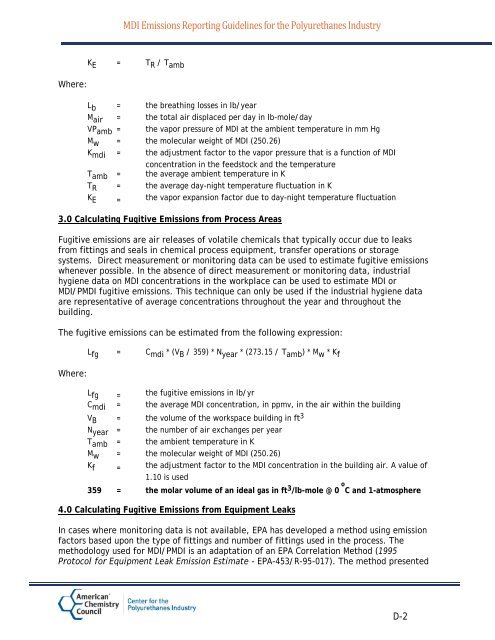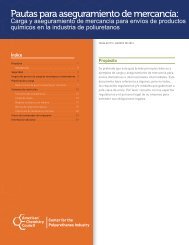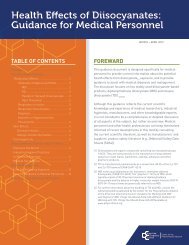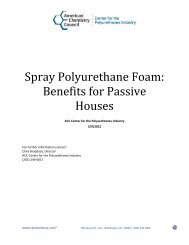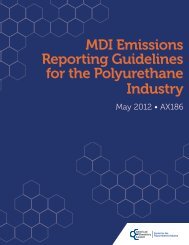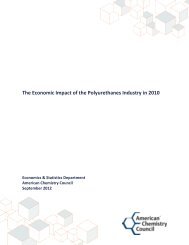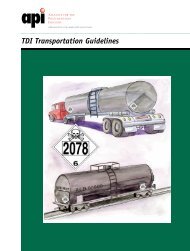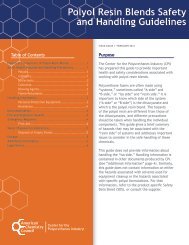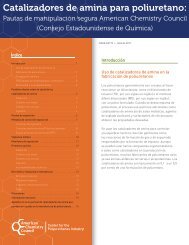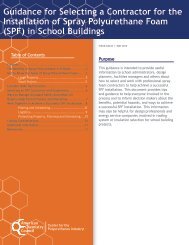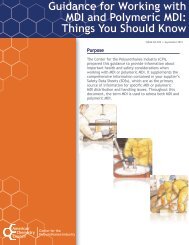MDI Emissions Reporting Guidelines for the ... - Polyurethanes
MDI Emissions Reporting Guidelines for the ... - Polyurethanes
MDI Emissions Reporting Guidelines for the ... - Polyurethanes
Create successful ePaper yourself
Turn your PDF publications into a flip-book with our unique Google optimized e-Paper software.
Where:<br />
<strong>MDI</strong> <strong>Emissions</strong> <strong>Reporting</strong> <strong>Guidelines</strong> <strong>for</strong> <strong>the</strong> <strong>Polyurethanes</strong> Industry<br />
K E = T R / T amb<br />
Lb = <strong>the</strong> breathing losses in lb/year<br />
Mair = <strong>the</strong> total air displaced per day in lb-mole/day<br />
VPamb = <strong>the</strong> vapor pressure of <strong>MDI</strong> at <strong>the</strong> ambient temperature in mm Hg<br />
Mw = <strong>the</strong> molecular weight of <strong>MDI</strong> (250.26)<br />
Kmdi = <strong>the</strong> adjustment factor to <strong>the</strong> vapor pressure that is a function of <strong>MDI</strong><br />
concentration in <strong>the</strong> feedstock and <strong>the</strong> temperature<br />
Tamb = <strong>the</strong> average ambient temperature in K<br />
TR = <strong>the</strong> average day-night temperature fluctuation in K<br />
KE = <strong>the</strong> vapor expansion factor due to day-night temperature fluctuation<br />
3.0 Calculating Fugitive <strong>Emissions</strong> from Process Areas<br />
Fugitive emissions are air releases of volatile chemicals that typically occur due to leaks<br />
from fittings and seals in chemical process equipment, transfer operations or storage<br />
systems. Direct measurement or monitoring data can be used to estimate fugitive emissions<br />
whenever possible. In <strong>the</strong> absence of direct measurement or monitoring data, industrial<br />
hygiene data on <strong>MDI</strong> concentrations in <strong>the</strong> workplace can be used to estimate <strong>MDI</strong> or<br />
<strong>MDI</strong>/P<strong>MDI</strong> fugitive emissions. This technique can only be used if <strong>the</strong> industrial hygiene data<br />
are representative of average concentrations throughout <strong>the</strong> year and throughout <strong>the</strong><br />
building.<br />
The fugitive emissions can be estimated from <strong>the</strong> following expression:<br />
Where:<br />
L fg = C mdi * (V B / 359) * N year * (273.15 / T amb ) * M w * K f<br />
Lfg = <strong>the</strong> fugitive emissions in lb/yr<br />
Cmdi = <strong>the</strong> average <strong>MDI</strong> concentration, in ppmv, in <strong>the</strong> air within <strong>the</strong> building<br />
VB = <strong>the</strong> volume of <strong>the</strong> workspace building in ft3 Nyear = <strong>the</strong> number of air exchanges per year<br />
Tamb = <strong>the</strong> ambient temperature in K<br />
Mw = <strong>the</strong> molecular weight of <strong>MDI</strong> (250.26)<br />
Kf = <strong>the</strong> adjustment factor to <strong>the</strong> <strong>MDI</strong> concentration in <strong>the</strong> building air. A value of<br />
1.10 is used<br />
359 = <strong>the</strong> molar volume of an ideal gas in ft3 /lb-mole @ 0 o<br />
C and 1-atmosphere<br />
4.0 Calculating Fugitive <strong>Emissions</strong> from Equipment Leaks<br />
In cases where monitoring data is not available, EPA has developed a method using emission<br />
factors based upon <strong>the</strong> type of fittings and number of fittings used in <strong>the</strong> process. The<br />
methodology used <strong>for</strong> <strong>MDI</strong>/P<strong>MDI</strong> is an adaptation of an EPA Correlation Method (1995<br />
Protocol <strong>for</strong> Equipment Leak Emission Estimate - EPA-453/R-95-017). The method presented<br />
D-2


